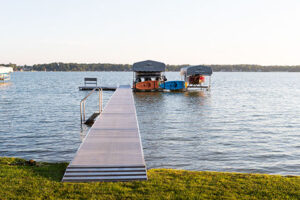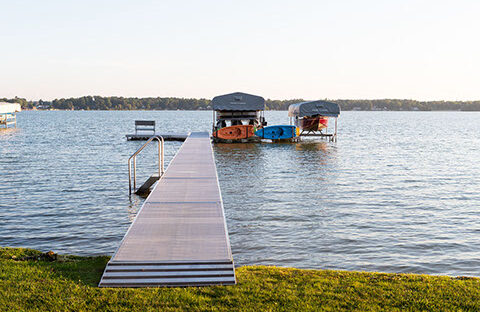Boat lifts eliminate the need to haul your water vessel in and out of the water, protecting the hull from damage. Boat Lifts For Sale Near Me prevents blistering, rust, and algae build-up.
Rougher water locations may require a more heavy-duty lift with extra bracing and reinforcement. Consider your vessel’s loaded weight and widest dimensions when choosing a lift.

A freestanding boat lift suspends a vessel from above a dock to provide protection against weather, debris and tidal changes. It also reduces wear and tear on a boat’s lower unit, blistering of the hull, and algae growth. Boat lifts are a great addition to any dock, helping you get the most from your boating experience.
To choose the right type of boat lift for your property, consider the size and type of your vessel. Determine how much weight it will carry, including passengers and gear. Then, find a model that will support the weight of your boat with ample room for safety. Choosing the right type of cradle is important, too. For example, excessive weight in the front or back of the cradle can damage cables and cause your lift to fail.
If you live in a rough water location, look for a lift with reinforced arms, mechanisms, and bolts. This extra strength will prevent excessive wear on your lift and dock, lowering maintenance costs. On the other hand, calmer water locations don’t need as much structural strength.
You should also pay attention to the lake bottom where you plan to install your boat lift. Do you have a hard, sandy or soft lake bottom? Determine this before you make any final decisions. Knowing the lake bottom will help you decide how heavy a lift should be and how wide of a space it should cover.
A boat lift makes it easier to park your boat, saving you time and effort when preparing for an outing. It can also protect your boat from damage caused by tidal changes and winter ice floes. It can even discourage thieves by making it harder for them to steal your vessel from your private dock.
A boat lift also makes it easier to enter and exit your boat. It raises the boat to dock level, reducing movement and the need for assistance from other people when getting on or off your boat. This is especially beneficial for families and groups of friends who are enjoying a day on the water together.
Floating boat lifts are a versatile marine system that is designed to support and raise your vessel above the water’s surface, helping to prevent hull damage, rust, fouling and algae growth. They provide a safe and convenient way to store your boat out of the water, making them ideal for any dock configuration or type of boat.
These lifts are built from high-density polyethylene cubes that work together to create a custom system that fits any configuration. These floating lifts don’t rely on motors or cables to function, making them simple to operate and extremely durable. They also don’t require regular lubrication, so there are no components that can break down or become damaged over time. Additionally, these lifts can be installed without the need for piles or a professional contractor to install them, saving you both time and money.
A floating lift is a great option for any homeowner looking to save on maintenance costs and protect their investment. By keeping your boat out of the water, you can avoid costly hull repairs and rusting, while maintaining a clean bottom that will improve fuel efficiency and reduce engine wear. These lifts are available in a variety of sizes to accommodate any boat, from a fishing vessel to a tri-hull or pontoon yacht.
When it comes to selecting the perfect boat lift for your property, it is important to understand your boat’s loaded weight and beam size. It is also important to consider the location where you will be installing the lift. This includes water depth measurements, soil firmness, wave/wake conditions, slip spacing and other factors that will affect your lift’s performance.
Choosing the right boat lift for your property is vital to protecting your investment and ensuring safe operation. Whether you’re looking for a freestanding, pile mounted, floating or drive on boat lift, has a solution that is sure to meet your needs. Contact us today to learn more about our extensive selection of quality marine products and services. Our friendly team is ready to assist you!
A boat lift keeps your watercraft out of the water when not in use, protecting it from damage and saving on maintenance costs. These lifts are typically placed in a dock slip and can either be freestanding or built into a seawall, bulkhead or existing dock system. There are a variety of different conventional lift types and options to choose from including hydraulic or cable/pulley/crank hoisting methods. If you’re thinking about purchasing a conventional lift, it’s important to take some measurements to make sure the model you’re considering will fit in your slip correctly. Taking this simple step will ensure you don’t have any problems when it comes time to install the lift and begin enjoying your boating adventures.
Most conventional boat lifts are four-post, with the berth brackets and tanks that cradle the vessel mounted on each side of the platform. When the system is activated, the floats fill with air and the berth brackets rise, lifting the boat into place. The lift is operated by turning a large wheel or activating a motor that extends and retracts stainless steel cables at each corner of the boat lift to raise or lower the structure.
Some of these lifts are designed with additional features to help the boat owner launch and park their boat more easily. These accessories can include things like guides that help the boat to align with the berth, canopies that hang over the lift to provide protection from precipitation and sun and full-length curtains that protect boats down to the hull.
For locations with rough waters that see frequent waves, rapid currents or high winds, a heavy-duty boat lift may be necessary to help reduce wear and tear on the support structure and the boat. These lifts are typically larger and feature more robust arms, mechanisms and bushings to better handle the extra strain put on the lift during harsh weather conditions.
No matter which type of lift you decide on, it’s essential to follow the recommended weight capacity. Exceeding this limit could cause damage to the lift and may even void your warranty.
While the majority of boat lifts connect to a dock system, freestanding lifts can stand alone. These types of lifts are ideal for locations with a diverse water conditions, including calm and rough areas. They can also be used on different bed surface types, such as muddy lake beds and rocky river beds. They don’t require connection to a docking system, making them easy to move in case you want to change locations. Freestanding lifts usually need to be removed during winter and reinstalled in the spring, but they can still be useful during these times, as they are more resistant to harsh weather than conventional lifts.
When selecting a lift, consider the make and model of your vessel as well as its dry weight. This will help you choose the right sized cradle for your boat, as you don’t want to exceed the recommended weight capacity. You should also take into account any additional gear or passengers you might have onboard when calculating your boat’s total weight. It is important to remember that if you have excessive weight in the front or back of your boat, it can cause damage to the lift cables.
Elevator systems differ from standard lifts in that they use rails (I-beam tracks) that are supported by your seawall or dock, rather than pilings. A reputable marine contractor should confirm that your dock structure can support the lift system before installation, as well as determine the ideal installation angle and track lengths.
One of the benefits of an elevator lift is that it can raise your boat higher off the water, which makes it easier to navigate. It also reduces the wear on your vessel, preventing corrosion and lessening the amount of maintenance needed over time.
Depending on the type of lift you choose, it may be necessary to install other watercraft equipment such as a bumper or a winch. These devices help keep your boat secure and prevents it from hitting other boats or the dock itself when moving in and out of the water.

